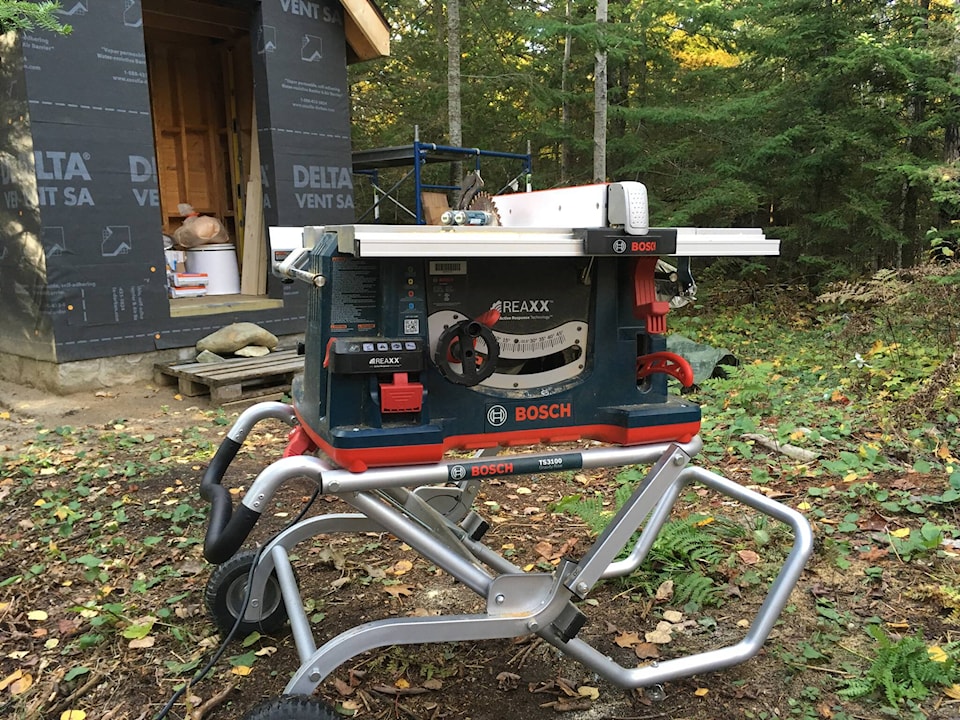Q: What should I look for when buying a portable table saw? I’m deciding between a benchtop model or a contractor model. What brands do you recommend?
A: Both contractor table saws and benchtop table saws are portable, and though contractor models are heavier and physically larger, there’s no significant difference between the two in terms of cutting power.
If you don’t plan to move your saw around much, then a contractor saw is probably best. The heavier weight and somewhat larger table surface makes sense.
As for benchtop models, I’ve used many different ones over the years. My favourite right now (and it has been my favourite for years) is the Bosch benchtop model with they call a “gravity rise stand”. There are wheels on this stand, making it easy to roll the saw around. The stand folds up more effectively than any other stand I’ve tried. Here in Canada we also have access to a version of the Bosch benchtop saw called REAXX. This model has a system that instantly drops the spinning blade safely below the table surface if the blade touches any kind of flesh. This impressive safety feature used to be available in all countries, but legal action around patents means woodworkers south of the border won’t find the saw on store shelves. We can still buy it here in Canada, though.
Soundproof Door
Q: What’s the best way to make an interior basement door soundproof? I’d like to be able to keep sound in some rooms that I’m finishing in my basement.
A: The thing about soundproofing is that the smallest openings can allow a lot of sound to move from one room to another. This is why air sealing is a vital part of soundproofing. That word “soundproofing” is widely used but a poor choice because it implies that sound can be kept out of an area completely. A better concept is to increase the ìsound resistanceî of a wall or ceiling or, in your case, a door.
With this in mind, the best option I know of is to install an insulated exterior residential door that comes pre-hung with weatherstripping. This isn’t usually done for interior doors, but I’ve never seen any door that blocks sound better than one of these. It’s not always desirable to have something that looks like an exterior door inside your basement, but there are good-looking options. Consider a door with a frame and panel design, or one, perhaps, with a window and divided lites.
Deck Board Spacing
Q: How far apart should I space the floorboards on the deck I’m building? I’ve seen 1/8’ recommended, but also as high as 1/4’ apart.
A: Deck board spacing is mostly an aesthetic thing, within limits at both the narrow and wide end of the spectrum, of course. You need some space to allow water to drain and resist clogging from dirt. It’s surprising how waterproof tightly packed dirt can be in the crack between deck boards. If the space gets clogged and remains wet between rains, then your deck boards will rot much faster than they otherwise would. This is why I specify a minimum of 1/8”. On the high end, you really should not go more than 3/16” or 1/4”. I find that if you go beyond 1/4” the deck starts looking bad ñ sort of like someone with missing teeth. Regardless of how far you space deck boards along their sides, I strongly recommend that you locate two-floor joists 1 inch apart wherever the ends of deck boards will land. This allows the ends of deck boards to be spaced apart to promote drying of the wood and rot resistance.
Steve Maxwell hates wood rot and does everything he can to prevent it. Visit Steve online at BaileyLineRoad.com for made-in-Canada articles and videos about home improvements, power tools, woodworking and growing your personal hands-on competence.
